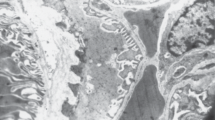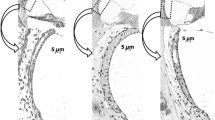Summary
The globular cells are typical elements of the connective tissue of Gastropods. Light- and electronmicroscopic investigations of Cepaea nemoralis have shown, that these cells are filled with variable contents of glycogen, accumulated in the centre of the cell. This crowds the cytoplasm and the cell organelles into the peripheral area, including the cell processes and a narrow band surrounding the nucleus. The typical element of the globular cell is a special differentiation of the cell surface, the so-called “Spaltenapparat”. The three-dimensional organisation of the “Spaltenapparat” has been analysed by serial ultrathin sections. The reconstruction shows, that the “Spaltenapparat” consists of numerous branched invaginations of the extracellular space covered by very small, winding cell processes; there are tiny clefts between them. There appears to be some similarity between the “Spaltenapparat” of the globular cells and the pedicels of the podocytes of the renal glomerulus.
Zusammenfassung
Die Blasenzellen stellen ein typisches Zellelement im Bindegewebe der Gastropoden dar. Licht- und elektronenmikroskopische Untersuchungen an Cepaea nemoralis haben gezeigt, daß der größte Teil einer Blasenzelle mit einer veränderlichen Glykogenmenge angefüllt ist. Diese zentrale Glykogenansammlung verdrängt das Zytoplasma mit seinen Organellen auf den peripheren Bereich der Zelle einschließlich der Zellausläufer und einen schmalen Saum um den Zellkern. Das wichtigste Identifizierungs-merkmal der Blasenzelle ist eine sehr spezialisierte — hier als Spaltenapparat bezeichnete — Oberflächendifferenzierung. Die Auswertung von Serienschnitten hat gezeigt, daß diese Oberflächenstruktur durch eine zum Teil verzweigte Invagination des extrazellulären Raumes gebildet wird, die wiederum von der Blasenzelle durch eine mäanderförmig unterbrochene Platte abgedeckt ist. Zwischen dem Spaltenapparat der Blasenzellen und dem Reusenapparat der Podozyten der Niere scheint eine Ähnlichkeit zu bestehen.
Similar content being viewed by others
Literatur
Adam, H., Czihak, G.: Arbeitsmethoden der makroskopischen und mikroskopischen Anatomie. Stuttgart: G. Fischer 1964.
Altner, H.: Die Ultrastruktur der Labialnephridien von Onychiurus quadriocellatus (Collembola) J. Ultrastruct. Res. 24, 349–366 (1968).
Arnold, M.: Histochemie. Berlin-Heidelberg-New York: Springer 1968.
Baecker, R.: Die Mikromorphologie von Helix pomatia und einigen anderen Stylommatophoren. Ergebn. Anat. Entwickl.-Gesch. 29, 449–585 (1932).
Baleydier, C., Nicaise, G., Pavans de Ceccatty, M.: Etat fibroblastique et différenciation fibrocytaire des cellules conjonctives de Glossodoris (Gastéropode, Opistobranche). C. R. Acad. Sci. (Paris) 269, 175–178 (1969).
Brock, J.: Untersuchungen über die interstitielle Bindesubstanz der Mollusken. Z. Zool. 39, 1–63 (mit Taf. I–IV) (1883).
Brooker, B. E.: Desmosomes and hemidesmosomes in the flagellate Crithidia fasciculata. Z. Zellforsch. 105, 155–166 (1970).
Buchholz, K., Kuhlmann, D., Nolte, A.: Aufnahme von Trypanblau und Ferritin in die Blasenzellen des Bindegewebes von Helix pomatia und Cepaea nemoralis (Stylommatophora, Pulmonata). Z. Zellforsch. 113, 203–215 (1971).
Coimbra, A., Leblond, C. P.: Sites of glycogen synthesis in rat liver cell as shown by electron microscope radioautography after administration of glucose—H3. J. Cell Biol. 30, 151–175 (1966).
Dallner, G., Siekevitz, P., Palade, G. E.: Biogenesis of endoplasmic reticulum membranes. I. Structural and chemical differentiation in developing rat hepatocyte. J. Cell Biol. 30, 73–117 (1966).
Drochmans, P.: Morphologie du glycogène. Etude au microscope électronique de colorations négatives du glycogène particulaire. J. Ultrastruct. Res. 6, 141–163 (1962).
Fernandez, J.: Nervous system of the snail Helix aspersa. I. Structure and histochemistry of ganglionic sheath and neuroglia. J. comp. Neurol. 127, 157–182 (1966).
Graumann, W., Clauss, W.: Untersuchungen zum cytochemischen Glykogennachweis. III. Mitteilung. Versuche zum Diastasetest. Histochemie 1, 241–246 (1959).
Groniowski, J., Biczyskowa, W., Walski, M.: Electron microscope studies on the surface coat of the nephron. J. Cell Biol. 40, 585–601 (1969).
Horstmann, H.-J.: β-Galaktosidase in den Embryonen von Lymnaea stagnalis. Hoppe-Seylers Z. physiol. Chem. 337, 57–60 (1964).
Komnick, H., Wohlfahrt-Bottermann, K. E.: Morphologie des Cytoplasmas. Fortschr. Zool. 17, 1–154 (1966).
Kushida, H.: A styrene-methacrylate resin embedding method for ultrathin sectioning. J. Electronmicr. 10, 16–19 (1961).
Lindner, E.: Die sublichtmikroskopische Anatomie des Herzmuskels. Z. Zellforsch. 45, 702–746 (1957).
Luck, D. J. L.: Glycogen synthesis from uridin diphosphate glucose. The distribution of the enzyme in liver cell fractions. J. biophys. biochem. Cytol. 10, 195–209 (1961).
Meller, K., Wagner, H. H.: Die Feinstruktur des Plexus chorioideus in Gewebekulturen. Z. Zellforsch. 86, 98–110 (1968).
Newman, G., Kerkut, G. A., Walker, R. J.: The structure of the brain of Helix aspersa. Electron microscope localization of cholinesterase and amines. Symp. zool. Soc. Lond. 22, 1–17 (1968).
Nieland, M. L., Goudsmit, E. M.: Ultrastructure of galactogen in the albumin gland of Helix pomatia. J. Ultrastruct. Res. 29, 119–140 (1969).
Revel, J. P., Napolitano, L., Fawcett, D. W.: Identification of glycogen in electron micrography of thin tissue sections. J. biophys. biochem. Cytol. 8, 575–589 (1960).
Rogers, D. C.: Fine structure of the epineural connective tissue sheath of the subesophageal ganglion in Helix aspersa. Z. Zellforsch. 102, 99–112 (1969).
Ruddell, C. L., Wellings, S. R.: The ultrastructure of the oyster brown cell, a cell with a fenestrated plasma membrane. Z. Zellforsch. 120, 17–28 (1971).
Russo, J.: Glykogen content during the postnatal differentiation of the Leydig cell in the mouse testis. Z. Zellforsch. 104, 14–18 (1970).
Sanchis, C. A., Zambrano, D.: The structure of the central nervous system of a pulmonate mollusc (Cryptomphallus aspersa). I. Ultrastructure of the connective epineural sheath. Z. Zellforsch. 94, 62–71 (1969).
Schmekel, L.: Zur Feinstruktur der Spezialzellen von normalernährten und hungernden Aeolidiern (Gastr. Nudibranchia). Z. Zellforsch. 124, 419–432 (1972).
Stang-Voss, Chr.: Zur Ultrastruktur der Blutzellen wirbelloser Tiere. III. Über die Haemocyten der Schnecke Lymnea stagnalis L. (Pulmonata). Z. Zellforsch. 107, 142–156 (1970).
Trump, B. F., Smuckler, E. A., Benditt, E. P.: A method for staining epoxy sections for light microscopy. J. Ultrastruct. Res. 5, 343–348 (1961).
Vrensen, G. F. J. M.: Further observations concerning the involvement of rough endoplasmic reticulum and ribosomes in early stages of glycogen repletion in rat liver. A combined biochemical and electron microscopic autoradiographic study. J. Microscopie 9, 517–534 (1970).
Wohlfahrt-Bottermann, K. E.: Die Kontrastierung tierischer Zellen und Gewebe im Rahmen ihrer elektronenmikroskopischen Untersuchung an ultradünnen Schnitten. Naturwissenschaften 44, 287–288 (1957).
Wondrak, G.: Die Ultrastruktur der Zellen aus dem interstitiellen Bindegewebe von Arion rufus (L.), Pulmonata, Gastropoda. Z. Zellforsch. 95, 249–262 (1969).
Author information
Authors and Affiliations
Additional information
Frau Prof. Dr. A. Nolte danke ich für anregende Diskussion, Frau R. Dingerdissen und Herrn Dr. Kappert für technische Hilfe.
Rights and permissions
About this article
Cite this article
Wolburg-Buchholz, K. Blasenzellen im Bindegewebe des Schlundrings von Cepaea nemoralis L. (Gastropoda, Stylommatophora). Z.Zellforsch 128, 100–114 (1972). https://doi.org/10.1007/BF00306891
Received:
Issue Date:
DOI: https://doi.org/10.1007/BF00306891




